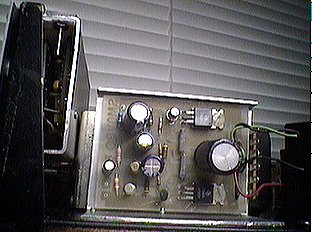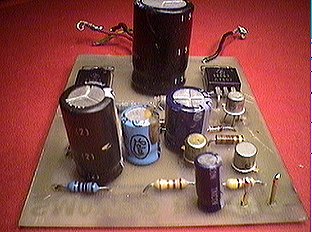Solid State Audio for Drake R4
Modifying the audio output circuit is a popular conversion for the R4C. Mainly because the factory supplied circuit can benefit from some help.
Converting the audio to solid state in an R4A or R4B does not provide any significant advantages other than reducing power consumption and providing room above and below the chassis for a decent low voltage power supply.

MODIFIED R4A
There is nothing wrong with the quality of the audio coming from the 6EH5, but it only delivers about one watt of audio while consuming over 5 watts of power. The result is lots of heat right next to the PTO. This does not appear to cause any problems. A solid state audio conversion here might be considered a solution to a problem that does not exist. However, if you need the extra space on the chassis for other things, if your 6EH5 is missing or bad, if you want to reduce power consumption and run a little cooler while getting a significant increase in audio output, then you may want to consider this modification.

SIDE VIEW OF THE MODIFICATION
A popular method of converting to solid state is to use an inexpensive audio power IC like the LM380. The LM380 solution is particularly easy, requires very few additional parts, and produces an unpleasent high frequency hiss.
One performance aspect of a really good communications receiver is that it is completely quiet when the antenna is disconnected and the gain is turned up all the way. No significant background hiss. That is pretty much the way unmodified Drake equipment performs. Why spoil that with an LM380?

ASSEMBLED 4-WATT AUDIO AMPLIFIER
This modification uses a 4-watt solid state audio amplfier designed by SM0VPO. His design uses lots of parts, but they are cheap parts. Its main advantage is that it is completely quiet. Absolutely no hissing, and has less distortion than most other audio amplifiers of this class. Details for constructing one of these 4-watt amps can be found at http://sm0vpo.8m.com/
A circuit board may be purchased from SM0VPO. Eventually, a complete kit may also be available. Or, you can make your own circuit board from the pattern he provides on his website.
The power requirements for the 4-watt audio amp are 12 vdc at 300ma. It is recommended that this power be supplied from a dedicated regulator attached to the unregulated output of the new low voltage power supply. A seperate regulator should be used to power other low voltage requirements in the radio.
-
HOME
OFF TOPIC BLOG
Amplifiers, audio
Amplifiers, RF
Antennas
Boatanchors
CW Keys
DRAKE radios
Equipment for Sale
Ham Radio Misc
Parts for Sale